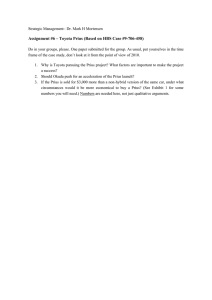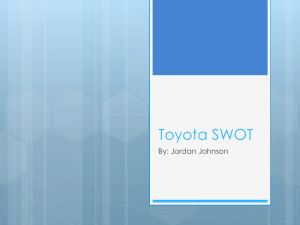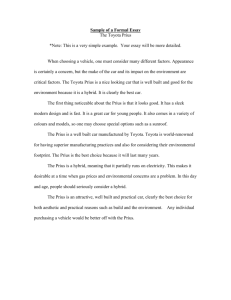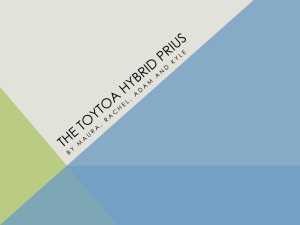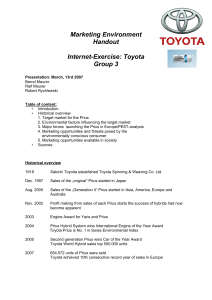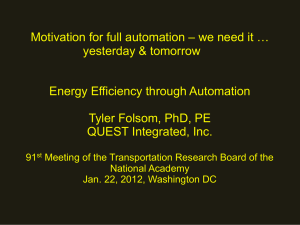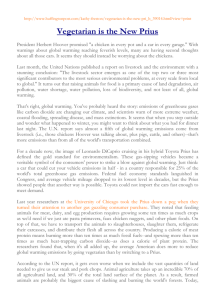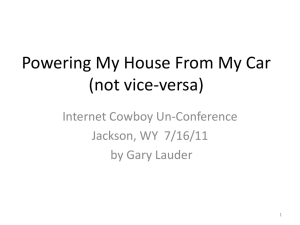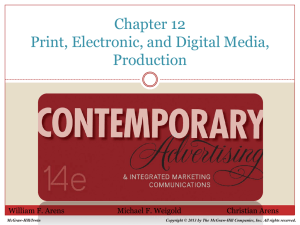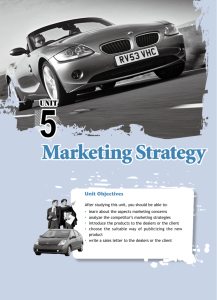Geri Yoza National Business Planning Manager – Toyota Motor
advertisement
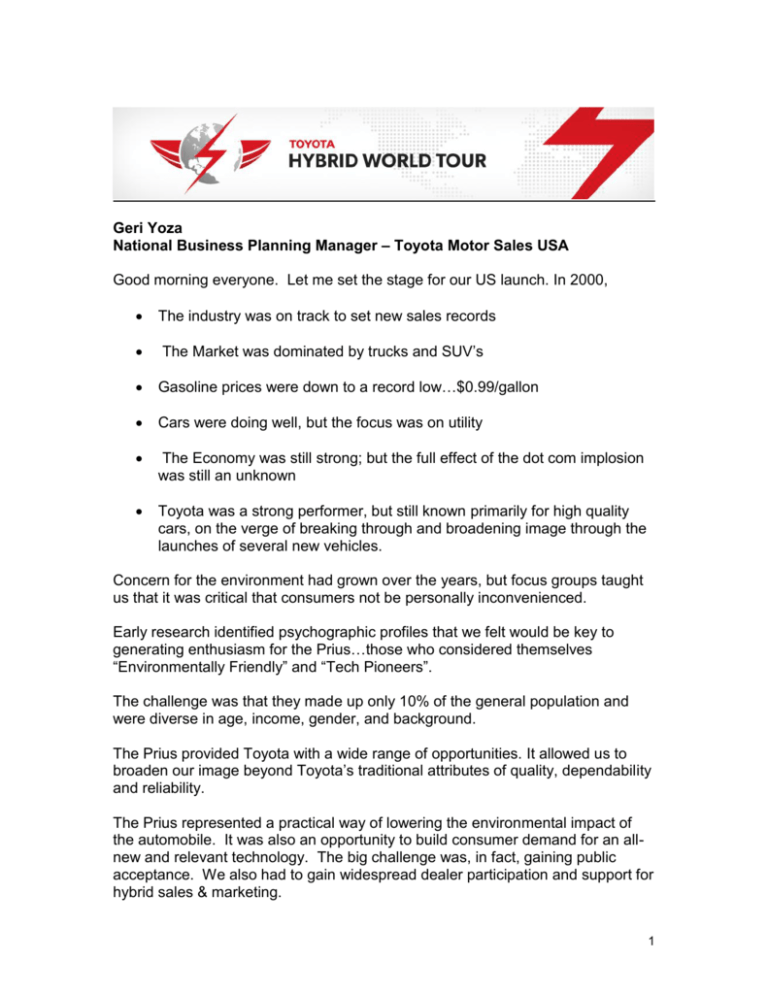
Geri Yoza National Business Planning Manager – Toyota Motor Sales USA Good morning everyone. Let me set the stage for our US launch. In 2000, The industry was on track to set new sales records The Market was dominated by trucks and SUV’s Gasoline prices were down to a record low…$0.99/gallon Cars were doing well, but the focus was on utility The Economy was still strong; but the full effect of the dot com implosion was still an unknown Toyota was a strong performer, but still known primarily for high quality cars, on the verge of breaking through and broadening image through the launches of several new vehicles. Concern for the environment had grown over the years, but focus groups taught us that it was critical that consumers not be personally inconvenienced. Early research identified psychographic profiles that we felt would be key to generating enthusiasm for the Prius…those who considered themselves “Environmentally Friendly” and “Tech Pioneers”. The challenge was that they made up only 10% of the general population and were diverse in age, income, gender, and background. The Prius provided Toyota with a wide range of opportunities. It allowed us to broaden our image beyond Toyota’s traditional attributes of quality, dependability and reliability. The Prius represented a practical way of lowering the environmental impact of the automobile. It was also an opportunity to build consumer demand for an allnew and relevant technology. The big challenge was, in fact, gaining public acceptance. We also had to gain widespread dealer participation and support for hybrid sales & marketing. 1 Traditionally, when we launch a vehicle, such as the Camry, we look at the overall market and the segment in which the vehicle competes. We identify a number of data points. We compile all of this information into a target buyer and message to reach that buyer. None of this information existed for a hybrid vehicle. We had no data because this was a new technology and an all new category. So launch development for the Prius started at a much more elementary level. We had the vehicle and needed to determine who would want it and how to reach them. The reality was that consumers didn’t know they wanted it. We had to create demand and a new market. Our conclusion was that we had to come up with new methods to launch and sell Prius. Education and awareness were critical to our pre-launch activities. You could say that our pre-launch in the US began in December 1997 with EVS-14 when we debuted a RHD Prius. From there, we did a Summer Tour and early test drives in 1998 to early 2000. We focused on media events all over the country including Earth Day, before other automakers took it seriously. We averaged over 150 grass-roots high tech and environmental events and educational outreach activities annually over this period. Prius was met with great enthusiasm. I think that can be summed up in a quote from one of the editors of Wired Magazine… “This thing is going to change the world!' In 1999, we were using prototype vehicles for test drives and events, but we couldn’t use them in advertising because they weren’t product correct. So instead of featuring a vehicle, we used our “leaf car” logo in a nationwide teaser print campaign to highlight Toyota’s technology. Prius also gave us the opportunity to connect with celebrities and influencers very early. Our Prius was featured in the hit show Curb Your Enthusiasm. Larry David’s producer contacted me and asked if he could borrow one for an early episode. I lent it to him after he signed a 1-page insurance waiver. Larry liked the vehicle so much, that his producer asked to borrow the vehicle for the rest of the year so he could write it into the entire season. I agreed, so long as he took good care not to damage the vehicle since it was one of only 5 in the US. 2 I mention this because it was the first time that Hollywood came to us to borrow the Prius, which later became a trend. This surprised us. As I mentioned earlier, we didn’t have any data for this vehicle so we had to talk to the general public. We hosted a contest in April 1999. People had to go online and submit an essay on why they wanted to drive the Prius. We placed Prius’ with five families in select cities for a month and then conducted in depth interviews about the technology, attitudes, and usage. The demo program was a way to conduct primary test research that helped us gain crucial insight on consumers and the product, increase awareness and media attention in key markets for the retail launch, and provided a source of leads – over 8,000 applicants --- for Prius pre-sale activities. Based on our research learning, we determined the most effective way to get Prius’ to buyers was through the Internet. We were one of the first in the auto industry to use an integrated digital marketing, ordering and shopping strategy. To start, we led buyers to the Prius mini site within Toyota.com. There, they could learn more about the vehicle and place a purchase request through the site. It was a unique model to sell a car to a sophisticated and intelligent buyer. It was a natural extension from learning about the vehicle, to buying a vehicle. For Toyota, it was the first time we utilized an Internet method in a sales platform. We had to make adjustments to make the process work, stripping out all the options except exterior color, offering one price and one lease nationwide. The site directed consumers to dealerships to finalize their transaction via email or phone. The vehicles were built when the order was finalized and received by Toyota HQ. This was also the first time we utilized live chat support. The web strategy was very successful in matching production to demand. With Prius, we knew precisely where the actual demand was, because distribution was based on actual customer orders. So, we eliminated many inefficiencies. The web strategy allowed for much needed exposure to the Prius target buyer. Most importantly, the Internet created a platform where we could engage directly with potential buyers, through chats, surveys and email communication and create the Prius community that still exists today. With the launch of new technology, Toyota designed and implemented new customer support programs to provide a “concern-free” image. 3 It was a priority for the Company to ensure that the technology did not get a black eye or tarnish Toyota’s reputation for quality. A strong lease was created to reduce consumer fears about product obsolescence and to communicate affordability. Strong warranties were designed, including an 8-year / 100K-mile warranty on the battery and hybrid componentry. Customers were protected by 3-year complementary maintenance and roadside assistance programs. Also, participating dealers met stringent requirements to sell Prius. To assure quality control and provide test drives of Prius at participating dealerships, over a thousand units were placed in dealer demo, prior to retail deliveries. Our consumer communication goal was to build awareness and generate interest in test drives of the vehicle. As mentioned earlier, the Prius launch was not a demographically driven launch; we targeted attitudes and beliefs. Our strategic alliances with health, environmental, and technology groups provided us with new source leads and enhanced our credibility. These alliances also provided us access to more interested parties, leading to an initial mailing list of over 43,000 handraisers prior to launch. We had a fully integrated media plan featuring “Prius Genius” to convey the intelligence of Prius and innovation of Toyota. However, we cancelled our media flights after the initial launch phase because we had a backlog of orders that took us through the following year. The launch of 1st Gen Prius was a once-in-a-life time opportunity. It created new brand image attributes in environmental leadership. It created new brand attributes in technology innovation. It developed a community connector. It supported building relationships with our customers through the Internet... and provided an opportunity to build upon success with future launches. Looking back, this was a pretty amazing experience. Now its my pleasure to introduce, my boss Ed Larocque National Brand Manager, Advanced Technology Vehicles... who will take us up to present day. ## ## ## 4
